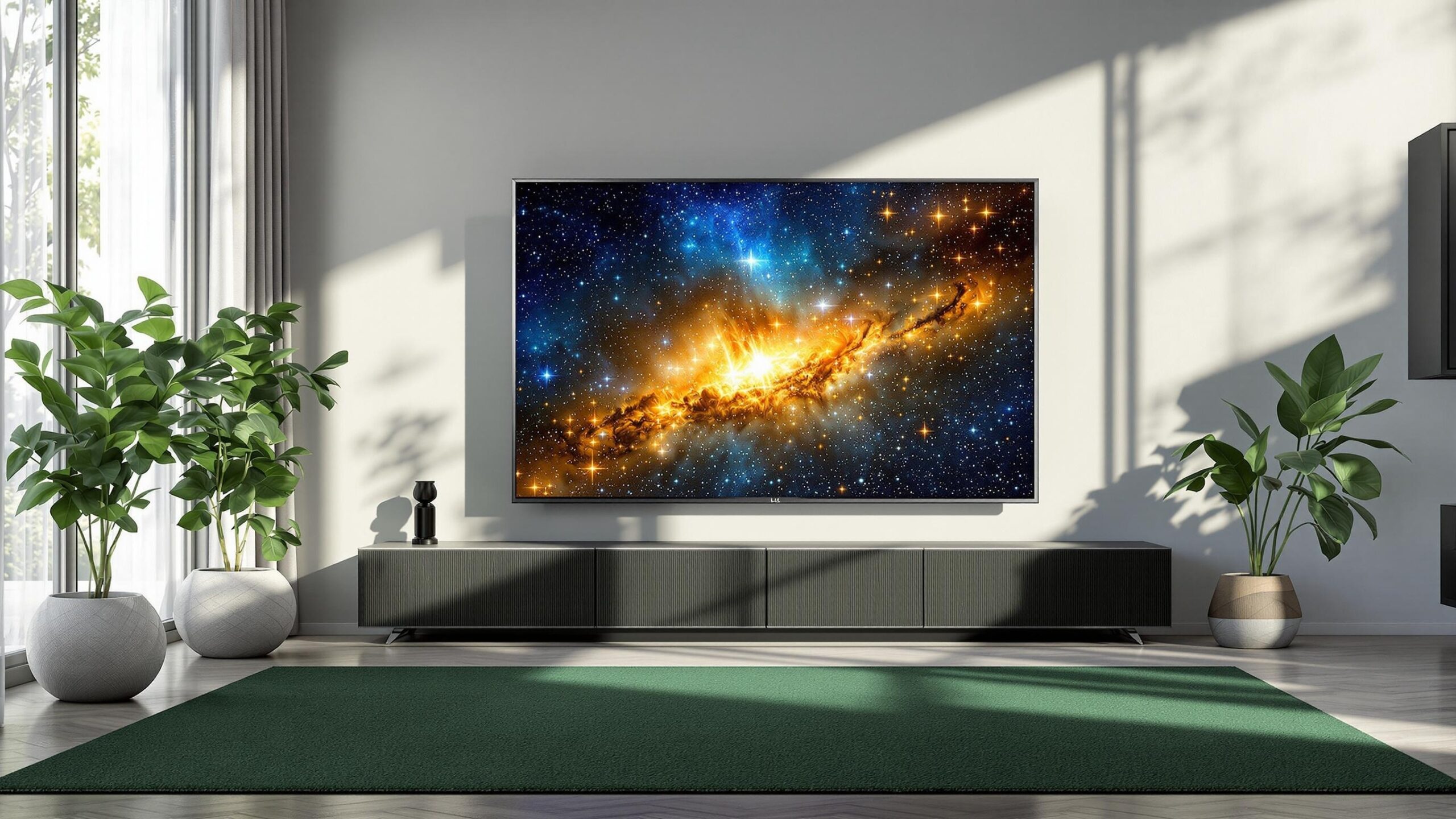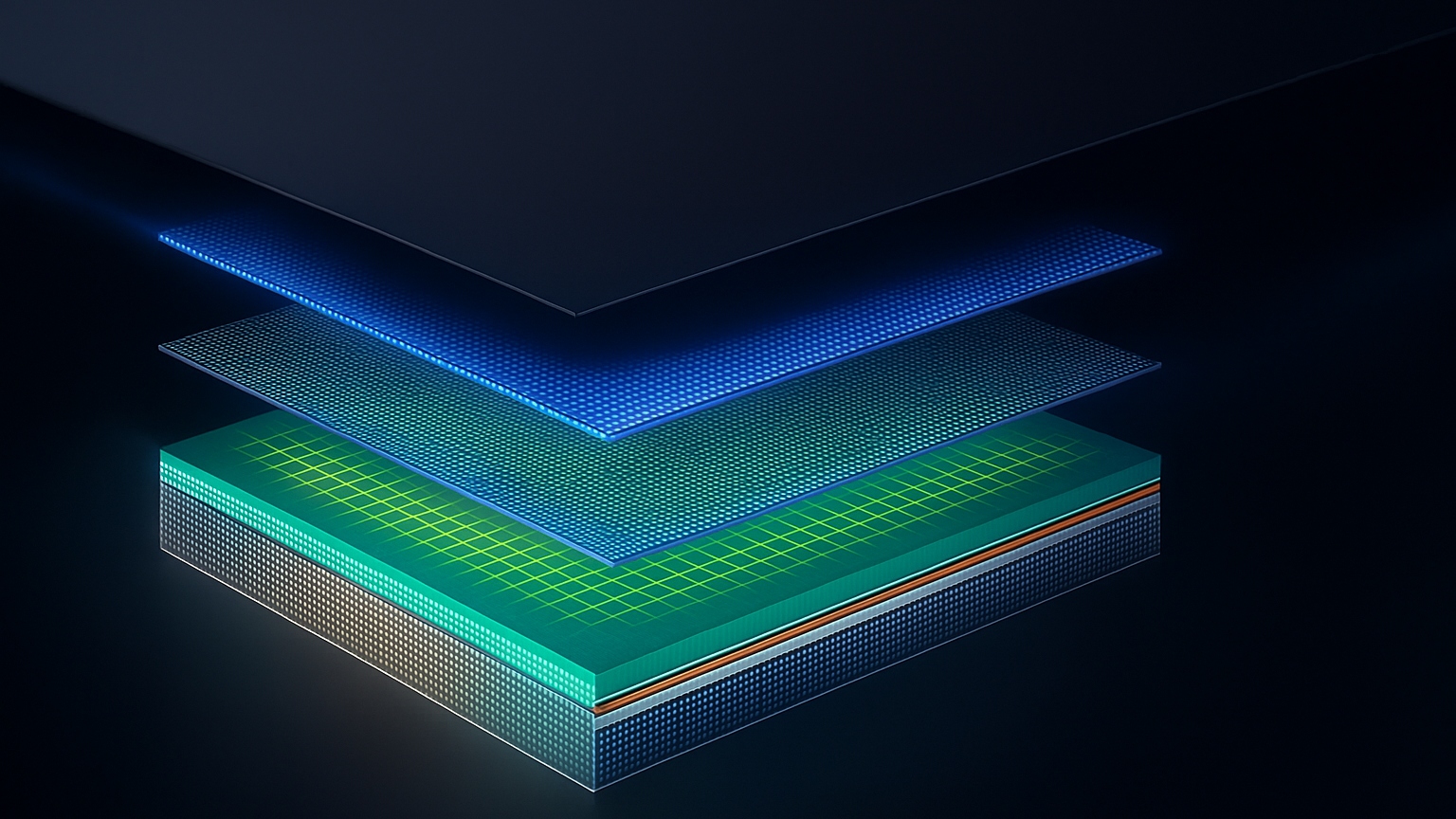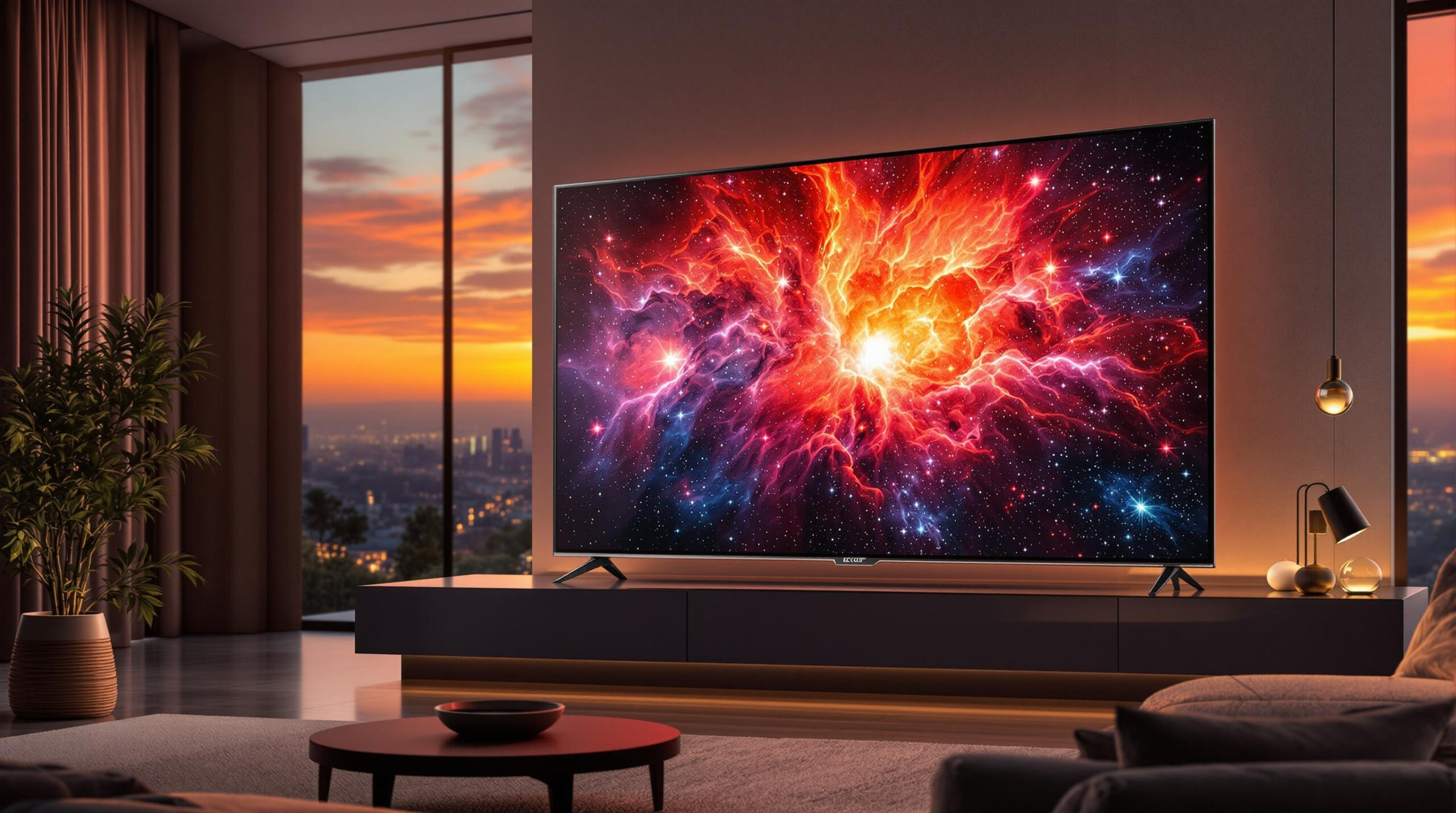When most shoppers compare televisions, they zero in on resolution—4K, 8K, and beyond—without realizing that contrast ratio exerts a deeper influence over how lifelike an image feels. Contrast is the difference between the darkest black a display can produce and its brightest white, and it governs everything from shadow detail in a moon-lit forest to the glare off a polished sports car. In QLED displays, contrast is dictated by an intricate dance of blue LEDs, quantum-dot chemistry, liquid-crystal physics, and micro-engineered backlights. Unpacking that dance reveals why a well-designed QLED can render images that pop with depth, dimensionality, and visual drama, even in brightly lit living rooms.
The Anatomy of a QLED Pixel: From Blue Photon to Full-Color Light
Every QLED pixel begins as blue light generated by a gallium-nitride LED. That light strikes a sheet filled with semiconductor nanocrystals—quantum dots—each only a few billionths of a meter across. Quantum mechanics locks an electron and a hole inside every dot like caged dancers; when the blue photon enters, it excites the pair, which then recombines and emits a new photon whose color depends on dot size. Larger dots glow red, smaller ones glow green, while any blue light that passes through completes the trio. Because quantum-dot emission bands are razor-narrow—roughly twenty-five nanometers wide—red stays ruby, green stays emerald, and no spectral stray light leaks into unwanted channels. That purity underpins high color volume, but it also lays the groundwork for superior contrast: the cleaner each primary is, the less white “fog” it drags into dark scenes.
LCD Shutters: The Inevitable Gatekeeper and Its Light Leakage
Above the quantum-dot film sits a liquid-crystal matrix that works like billions of microscopic blinds. Electric fields twist elongated organic molecules, adjusting how much polarized light they pass. Even at maximum “closed” voltage the crystals never block all photons. Some slip through due to imperfect alignment, disclination lines, and tiny gaps in the black matrix around each sub-pixel. Left unchecked, that leakage lifts black levels to a murky gray, crushing contrast to a few hundred to one. The challenge for QLED engineers is to strangle stray photons before they reach the viewer, without strangling brightness and color in the process.
Backlighting Evolution: Edge-Lit to Full-Array to Mini-LED
Early LCD TVs used fluorescent lamps uniformly bathing the screen; all pixels shared the same light pool, so a starfield at night looked like oatmeal. Edge-lit LED sets improved efficiency but still flooded the panel from its borders, leaving most of the backlight on even in dark shots. Full-array local dimming arrived next, positioning hundreds of LEDs behind the liquid crystal so zones could dim independently. Contrast ratios jumped an order of magnitude, yet haloing—bright rings around subtitles or campfires—remained visible because zones were still too coarse. The mid-2020s brought mini-LED backlights; by shrinking each diode under two hundred micrometers, engineers pack thousands of addressable zones across the panel. Mini-LED grids dim narrowly, starving the liquid-crystal shutter of photons wherever the video signal demands black, pushing on-off contrast well past fifty-thousand to one in real-scene measurements.
Local Dimming Algorithms: Real-Time Light Sculpting
Hardware alone cannot deliver great contrast. Each frame must be analyzed, mapped to the zone grid, and translated into millisecond-level drive currents. Image processors convert incoming RGB to luminance maps, predict motion vectors, and balance three competing goals: deepen blacks, avoid blooming, and preserve highlight detail. If a backlight zone dims too slowly, letterbox bars pulse with brightness; dim too aggressively and it crushes faint stars. Advanced QLEDs train neural networks on terabytes of movie and sports footage, teaching them to spot where our eyes expect detail so they can prioritize power to those LEDs. The result is contrast that dynamically adapts shot by shot, scene by scene, without the viewer sensing the machinery behind the curtain.
Static, Dynamic, and ANSI Contrast: Decoding the Metrics
Manufacturers often tout million-to-one “dynamic” contrast numbers measured by turning the entire screen black and then white. That figure flatters marketing copy but says nothing about simultaneous deep blacks and dazzling whites in the same frame. ANSI contrast, captured with a checkerboard pattern, and real-scene contrast, captured with HDR test sequences, provide truer insight. In controlled labs a flagship mini-LED QLED regularly hits four-to-five thousand to one ANSI contrast—double that of mid-tier edge-lit LCDs. More telling, it sustains over two thousand nits of peak highlight while clamping black bars below 0.002 nits, enabling HDR specular flashes that you can still perceive under living-room lighting.
Quantum-Dot Chemistry: Why Inorganic Matters for Black Levels
Contrast is not only about dark; it is equally about bright. Red phosphors in older white-LED LCDs bleed yellow at high drive currents, contaminating adjacent pixels and desaturating highlights. Quantum dots sidestep the issue because they convert color rather than filter it; the emitted light carries virtually no unwanted wavelengths, so adjacent pixels stay dark unless deliberately addressed. Inorganic dots are also impervious to photo-oxidation at HDR intensities. Over fifty thousand hours they retain more than ninety percent of their initial output, so black level rise—common as backlights age—slows dramatically. By ensuring bright stays bright without back-scattering into dark, quantum-dot chemistry protects contrast year after year.
Liquid-Crystal Modes and Compensation Films: Fighting Off-Axis Washout
Vertical-alignment (VA) liquid crystals dominate QLED panels because they leak less light when closed than the in-plane-switching (IPS) molecules common in laptops. VA’s drawback is color and contrast drop at wide angles; the molecular helix unwinds unevenly, letting polarized photons spill through. To counter that, engineers laminate phase-retarding compensation films that pre-rotate the polarization state differently for oblique rays, flattening the viewing-cone dip. Premium QLEDs combine those films with prism sheets that shear off-axis stray light into the absorber layer. The result: above eighty percent of on-axis contrast holds even at fifty-five degrees—good enough for big family couches without sacrificing VA’s superior black floor.
Mini-LED Thermal Management: The Dark Side of Brightness
Pushing thousands of LEDs past two thousand nits dumps significant heat behind the LCD glass. Hot spots raise local crystal temperature, making shutters leakier and elevating black levels. QLED backplanes therefore integrate graphite vapor-chamber heat spreaders and copper fin arrays bonded with thermal epoxy. Real-time sensors map temperature across the sheet; algorithms dial down current in overheated zones or pulse drive to distribute thermal load, keeping leakage within specification. By preventing thermal bloom, cooling systems lock the baseline luminance to micro-candela levels, preserving contrast during marathon gaming sessions or bright-room daytime viewing.
Measurement Challenges: The Human Eye, Ambient Light, and ABL
Contrast is not perceived in a vacuum. Ambient room light fills dark areas with reflections, and the eye’s pupils contract under bright highlights, raising the black threshold. Engineers therefore design matte, low-reflectance coatings that scatter incident light into harmless directions and specify maximum panel gloss values below two percent. They also moderate average picture brightness with automatic brightness limiting; the backlight dims large bright surfaces to protect power budgets, which incidentally stops pupils from constricting so much that blacks appear lighter. Balancing ABL and local dimming preserves the relative ratio the eye sees, ensuring lab contrast gains translate into couch-level wow.
The OLED Comparison: Infinite Contrast vs. High-Ambient Reality
OLED panels, whose pixels self-extinguish, achieve mathematically infinite on-off contrast in dark rooms. Yet in daylight the story changes. Because OLEDs top out under one thousand nits, bright ambient light can elevate their perceived black floor more than that of a two-thousand-nit QLED. Studies with controlled glare boxes show that in rooms lit above three hundred lux—a typical afternoon living-room level—flagship QLEDs score higher perceived contrast than OLEDs, despite inferior lab-dark measurements. The takeaway: raw ratios are a starting point, but brightness headroom and glare suppression decide real-world performance.
Future Frontiers: Micro-LED and Quantum-Dot OLED Hybrids
Display engineers aim for per-pixel dimming married to QLED’s color and brightness. Micro-LED arrays place individual inorganic diodes under each sub-pixel, giving them OLED-like control plus mini-LED luminance, but mass transfer of millions of microscopic chips challenges yield and cost. QD-OLED flips the stack: an OLED blue emitter layer pumps quantum-dot stripes for red and green, merging infinite blacks with quantum-dot purity, though at present brightness hovers around one thousand nits. Whichever road wins, lessons from QLED contrast engineering—neural dimming algorithms, advanced compensation films, thermal-aware drive schemes—will migrate forward, ensuring future screens keep pushing the limits of visible detail.
Conclusion: Engineering Darkness and Light in Perfect Balance
Understanding contrast ratios in QLED displays demands a journey through quantum-dot chemistry, liquid-crystal physics, LED micro-fabrication, and real-time image processing. Each discipline contributes a piece of the puzzle: nanocrystals isolate pure primaries; vertical-alignment cells tamp down leakage; mini-LED grids carve light with thousand-zone precision; AI dimming engines choreograph photons to match the source. The payoff is cinematic depth in bright rooms, star-filled skies unmarred by halo glow, and animated worlds whose saturated highlights never wash out the shadows beneath. Next time you marvel at a QLED’s night-time cityscape blazing against jet-black towers, remember that millions of coordinated engineering decisions made that contrast possible—and that the quest for deeper blacks and brighter whites continues with every new generation of quantum-dot display.
QLED TV Reviews
Explore Philo Street’s Top 10 Best QLED TV Reviews! Dive into our comprehensive analysis of the leading QLED TV products, complete with a side-by-side comparison chart to help you choose the perfect protection for your devices.




